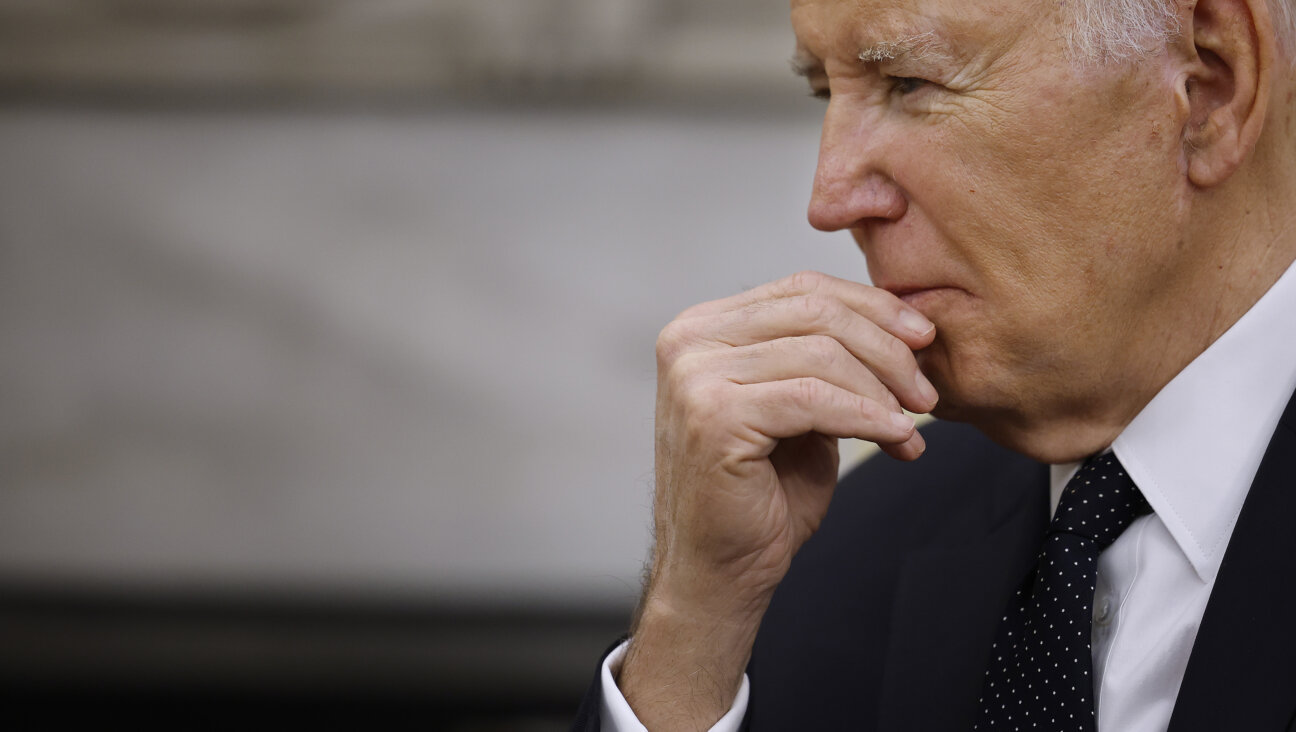The Jewish McLuhan
The Future of Art in a Digital Age: From Hellenistic to Hebraic Consciousness
By Mel Alexenberg
Intellect, 187 pages, $60.
As a wakeup call to “an indifferent world” and “Jews with their heads in the sand,” Mel Alexenberg designed a Holocaust memorial to honor the 6 million Jews in Israel “incinerated by an Iranian nuclear bomb that is Iran’s prelude to global conquest in the service of a mad ideology.”
Although the word “memorial,” according to the Oxford English Dictionary, derives from the Latin memoria (“memory”), Alexenberg has no qualms about memorializing events that have yet to occur. He certainly won’t be spitting three times, muttering “ken ayin hara” or throwing salt. “To hell with an evil eye,” he told the Forward in an e-mail. “It is evil to sit back and do nothing.”
Alexenberg’s project, titled “Future Holocaust Memorials,” has its own blog, http://futureholocaustmemorials.blogspot.com/, and is just one of several new-media Jewish art projects that Alexenberg has launched. He has tied prayer shawl strings to the four “corners” of America (Washington, San Diego, Maine and Florida), faxed “cyberangles” (based on Rembrandt’s work) across the globe, built an eruv (ritual border) around the city of Sodom and used a kabbalistic system that matches colors with Hebrew letters to map out the Bible in lights. These pieces and more are collected in Alexenberg’s new book, “The Future of Art in a Digital Age: From Hellenistic to Hebraic Consciousness.”
Alexenberg’s interest in digital art stems from his belief that art and science are “integrally one in the human psyche,” which “only need to be merged in postmodernism because they were artificially torn apart.” Alexenberg says that when he was a child, he used to conduct “scientific and artistic activities” with salamanders in the Catskills, “without a clue that they were considered different areas of human endeavor.” That childish playfulness and obliviousness to the boundaries of disciplines have apparently stuck with the artist, who refers to the Talmud’s “hypertext Internet-like design… that demands that it be studied in multiple ways unlike the one-way linear reading of other books.”
Alexenberg would seem to be an unlikely herald of Talmud-as-hypertext. The bearded artist, who wears a black hat and Hasidic garb in many of his promotional images, is the founding dean of the art school at Netanya Academic College in Israel. He was chairman of fine arts at the New York-based Pratt Institute, and a professor of art at Columbia University and at Bar-Ilan University. He also served as a research fellow at Massachusetts Institute of Technology’s Center for Advanced Visual Studies and as dean of visual arts at Miami’s New World School of the Arts before moving to Petah Tikvah, where he now lives.
His book’s premise centers on what Alexenberg calls a paradigm shift between Hellenistic and Hebraic consciousness. Alexenberg cites Norwegian theologian Thorleif Boman, whose book “Hebrew Thought Compared With Greek” (W.W. Norton & Company, 2002) defines Hellenism as a “static, peaceful, moderate, harmonious” art that spans from the Renaissance to modernism, whereas Hebraic thinking is “dynamic, vigorous, passionate, explosive,” or new-media art. A well-versed student of art history, Alexenberg rallies names no less significant than Frank Lloyd Wright and Frank Gehry to prove his point. He calls Wright “the son of a Unitarian minister,” who “internalized the biblical message of freeing humanity from enslavement in closed spaces and expressed his freedom in his architectural design.” Gehry, meanwhile, who was born Frank Goldberg, used to play with the carp swimming in his grandmothers’ bathtub. In Alexenberg’s conception, “The vigorous body motions of swimming fish seen from above gave Gehry his vocabulary for the dynamic shape of his museum,” the Guggenheim in Bilbao, Spain.
If Jacques Derrida had not preceded him, Alexenberg would be the Jewish Marshall McLuhan. He talks about the “endless flow” of the spiral Torah scroll “in contrast with the same content trapped between the covers in a codex book form.” He sees the Internet as a tool for translation and simultaneous unification and diversity that reverses the transgression of the Tower of Babel. Like McLuhan, Alexenberg is vulnerable to criticism for the breadth of his seemingly all-inclusive message that could prove either brilliance or utter nonsense.
But Alexenberg stresses that he is not a philosophy professor who never realizes his theories in the real world: “As an artist, I am always seeking new ways to realize theory/concept in space and time.” He even tries to use his art in areas where politics is failing. His exhibit Cyberangels: Aesthetic Peace Plan for the Middle East, which was shown in Prague, proposes an aesthetic solution to the Arab-Israeli conflict by highlighting an aspect of Islamic art that incorporates both geometric patterns and disrupting counter-patterns to show that “human creation is less than perfect.” Israel, then, can represent that counter-pattern of iconoclasm that leads the Islamic world to recognize “that they need Israel to realize their Islamic religious values.”
In this project, Alexenberg is most like McLuhan, who told Playboy in 1969 that the artist, and not the scientist, should be called upon to perceive and foresee new trends, because “inherent in the artist’s creative inspiration is the process of subliminally sniffing out environmental change.” Perhaps he will not have the opportunity to resolve the Arab-Israeli conflict, and hopefully he will not be called upon to truly memorialize Israel, but Alexenberg’s art and scholarship represent some of the most innovative work being made in both the Jewish and non-Jewish art world.
Menachem Wecker is a painter and editor based in Washington, D.C. He recently began blogging about religion and the arts at http://iconia.canonist.com/.

I hope you appreciated this article. Before you go, I’d like to ask you to please support the Forward’s award-winning, nonprofit journalism during this critical time.
Now more than ever, American Jews need independent news they can trust, with reporting driven by truth, not ideology. We serve you, not any ideological agenda.
At a time when other newsrooms are closing or cutting back, the Forward has removed its paywall and invested additional resources to report on the ground from Israel and around the U.S. on the impact of the war, rising antisemitism and the protests on college campuses.
Readers like you make it all possible. Support our work by becoming a Forward Member and connect with our journalism and your community.
Make a gift of any size and become a Forward member today. You’ll support our mission to tell the American Jewish story fully and fairly.
— Rachel Fishman Feddersen, Publisher and CEO
Join our mission to tell the Jewish story fully and fairly.























